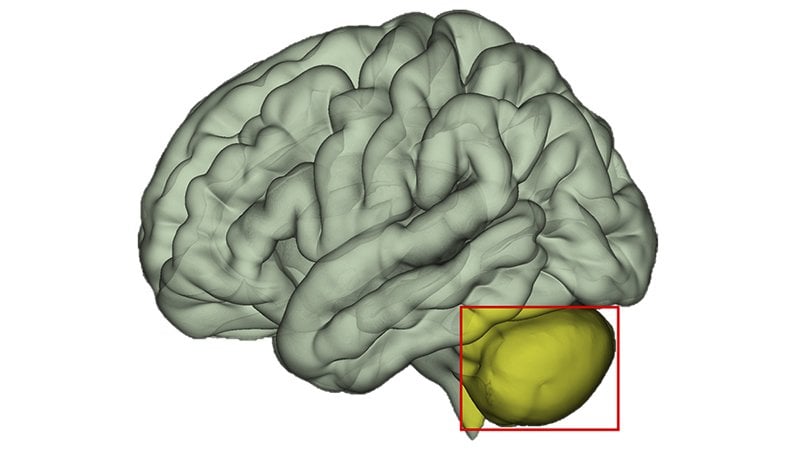Summary: New findings dispute the popular cerebellar deficit hypothesis of dyslexia. Researchers report the cerebellum is not engaged during reading in typical readers and does not differ in children with dyslexia.
Source: Georgetown University Medical Center
New brain imaging research debunks a controversial theory about dyslexia that can impact how it is sometimes treated, Georgetown University Medical Center neuroscientists say.
The cerebellum, a brain structure traditionally considered to be involved in motor function, has been implicated in the reading disability known as developmental dyslexia. However, this “cerebellar deficit hypothesis” has always been controversial. The new research shows that the cerebellum is not engaged during reading in typical readers and does not differ in children who have dyslexia.
That finding comes from a new study involving children with and without dyslexia published October 9, 2019, in the journal Human Brain Mapping.
It is well established that dyslexia, a common learning disability, involves a weakness in understanding the mapping of sounds in spoken words to their written counterparts, a process that requires phonological awareness. It is also well known that this kind of processing relies on brain regions in the left cortex. However, it has been argued by some that the difficulties in phonological processing that lead to impaired reading originate in the cerebellum, a structure outside (and below the back) of the cortex.
“Prior imaging research on reading in dyslexia had not found much support for this theory called the cerebellar deficit hypothesis of dyslexia, but these studies tended to focus on the cortex,” says the study’s first author, Sikoya Ashburn, a Georgetown PhD candidate in neuroscience. “Therefore, we tackled the question by specifically examining the cerebellum in more detail. We found no signs of cerebellar involvement during reading in skilled readers nor differences in children with reading disability.”
The researchers used functional magnetic resonance imaging to look for brain activation during reading. They also tested for functional connections between the cerebellum and the cortex during reading.

The image is adapted from the Georgetown University news release.
“Functional connectivity occurs when two brain regions behave similarly over time; they operate in sync,” says Ashburn. “However, brain regions in the cortex known to partake in the reading process were not communicating with the cerebellum in children with or without dyslexia while the brain was processing words.”
The results revealed that when reading was not considered in the analysis — that is, when just examining the communications between brain regions at rest — the cerebellum was communicating with the cortex more strongly in the children with dyslexia.
“These differences are consistent with the widely distributed neurobiological alterations that are associated with dyslexia, but not all of them are likely to be causal to the reading difficulties,” Ashburn explains.
“The evidence for the cerebellar deficit theory was never particularly strong, yet people have jumped on the idea and even developed treatment approaches targeting the cerebellum,” says senior author and neuroscientist Guinevere Eden, D. Phil, professor in the Department of Pediatrics at Georgetown University Medical Center and director for its Center for the Study of Learning. “Standing on a wobble board — one exercise promoted for improving dyslexia that isn’t supported by the evidence — is not going to improve a child’s reading skills. Such treatments are a waste of money and take away from other treatment approaches that entail structured intervention for reading difficulties, involving the learning of phonologic and orthographic processing.”
In the long run, these researchers believe the findings can be used to refine models of dyslexia and to assist parents of struggling readers to make informed decisions about which treatment programs to pursue.
Funding: This work was supported in part by grants from the Eunice Kennedy Shriver National Institute of Child Health and Human Development (P50 HD040095, R01 HD081078), and the National Center for Advancing Translational Sciences of the National Institutes of Health (TL1 TR001431).
Source:
Georgetown University Medical Center
Media Contacts:
Karen Teber – Georgetown University Medical Center
Image Source:
The image is adapted from the Georgetown University news release.
Original Research: Open access
“Cerebellar function in children with and without dyslexia during single word processing”. Sikoya M. Ashburn, D. Lynn Flowers, Eileen M. Napoliello, Guinevere F. Eden.
Human Brain Mapping doi:10.1002/hbm.24792.
Abstract
Cerebellar function in children with and without dyslexia during single word processing
The cerebellar deficit hypothesis of dyslexia posits that dysfunction of the cerebellum is the underlying cause for reading difficulties observed in this common learning disability. The present study used functional magnetic resonance imaging (fMRI) and a single word processing task to test for differences in activity and connectivity in children with (n = 23) and without (n = 23) dyslexia. We found cerebellar activity in the control group when word processing was compared to fixation, but not when it was compared to the active baseline task designed to reveal activity specific to reading. In the group with dyslexia there was no cerebellar activity for either contrasts and there were no differences when they were compared to children without dyslexia. Turning to functional connectivity (FC) in the controls, background FC (i.e., not specific to reading) was predominately found between the cerebellum and the occipitaltemporal cortex. In the group with dyslexia, there was background FC between the cerebellum and several cortical regions. When comparing the two groups, they differed in background FC in connections between the seed region right crus I and three left‐hemisphere perisylvian target regions. However, there was no task‐specific FC for word processing in either group and no between‐group differences. Together the results do not support the theory that the cerebellum is affected functionally during reading in children with dyslexia.







